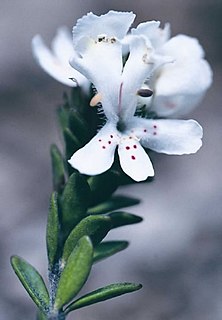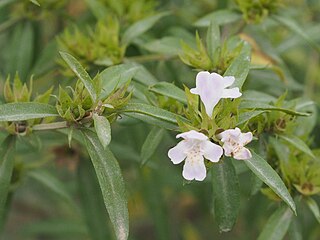
Eucalyptus curtisii, commonly known as Plunkett mallee, is a species of mallee or small tree that is endemic to south-east Queensland in Australia. It has smooth grey to silvery bark, lance-shaped, narrow elliptic or curved adult leaves, flower buds in groups of seven, white flowers and wrinkled, cup-shaped fruit.

Eucalyptus viridis, commonly known as the green mallee, is a species of mallee or small tree that is endemic to south-eastern, continental Australia. It has rough fibrous or flaky bark on the lower trunk, smooth bark above, linear to narrow lance-shaped adult leaves, flower buds in groups of seven or nine, white flowers and cup-shaped fruit.

Westringia eremicola, commonly known as slender westringia or slender western rosemary, is a flowering plant in the family Lamiaceae and is endemic to eastern Australia. It is a small shrub, with narrow leaves and pink, mauve to white flowers.

Eucalyptus approximans, commonly known as the Barren Mountain mallee, is a mallee endemic to a small area of New South Wales. It has smooth bark, linear to lance-shaped or curved adult leaves, club-shaped buds in groups of seven in the leaf axils, white flowers and cylindrical to cup-shaped fruit.

Eucalyptus bakeri, commonly known as Baker's mallee or the mallee box, is a eucalypt that is endemic to eastern Australia. It has fibrous bark on the trunk and smooth white or grey bark above, narrow lance-shaped leaves, flower buds in groups of between seven and thirteen, white flowers and hemispherical or shortened spherical fruit.
Eucalyptus infera, commonly known as the Durikai mallee, is a species of mallee, rarely a small tree, that is endemic to Queensland. It has smooth grey bark, broadly lance-shaped to egg-shaped leaves, flower buds in groups of between nine and eighteen, white flowers and hemispherical fruit.

Prostanthera parvifolia is a species of flowering plant in the family Lamiaceae and is endemic to Queensland. It is an upright shrub with small, pale green leaves and mostly deep mauve flowers.
Xerothamnella parvifolia, also known as the Small-leaved Little Dry Shrub, is a species of plant in the acanthus family that is endemic to Australia.

Westringia kydrensis, also known as the Kydra Westringia, is a species of plant in the mint family that is endemic to Australia.

Westringia saxatilis is a species of plant in the mint family that is endemic to Australia.

Westringia davidii, also known as David's Westringia, is a species of plant in the mint family that is endemic to Australia.

Westringia amabilis is a species of flowering plant in the family Lamiaceae and grows in New South Wales and Queensland. It is a small shrub with ovate-shaped leaves and light mauve to white flowers and brownish spots in the throat.

Westringia sericea, also known as native rosemary or silky rosemary, is a species of plant in the mint family that is endemic to Australia.

Westringia lucida, also known as Shining Westringia, is a species of plant in the mint family that is endemic to Australia.

Westringia blakeana is a flowering plant in the family Lamiaceae and grows in New South Wales and Queensland. It is a small shrub with mauve to whitish flowers with brown spots and leaves arranged in whorls.

Westringia rupicola is a species of plant in the mint family that is endemic to Australia.

Westringia ophioglossa is a species of plant in the mint family that is endemic to Western Australia.

Westringia fitzgeraldensis is a species of plant in the mint family that is endemic to Western Australia.

Westringia discipulorum, also known as white button bush, is a species of plant in the mint family that is endemic to Western Australia.

Westringia cheelii is a species of plant in the mint family that is endemic to Australia.



















